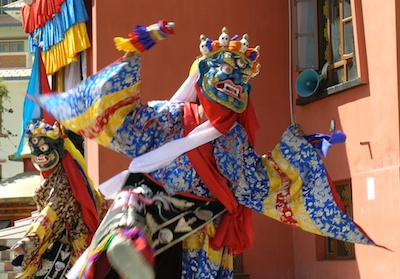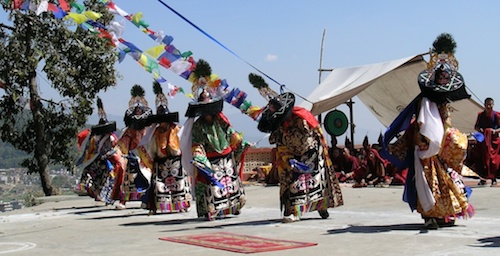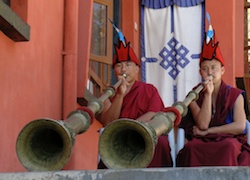Since the Tibetan Losar celebration for the New Year of the Wood Horse is on March 2nd, I thought it would be useful to share some of the customs and rituals around this important holiday.
 Losar marks the most important holiday for Tibetans, and is celebrated over several weeks with rituals and dances. It is a lunar holiday, falling on a new moon usually in February or March. Sometimes it coincides with the Chinese New Year celebrations, but this year it does not. Most of the rituals performed in Tibetan monasteries precede the actual day of Losar, but there is also a flurry of celebrations on the actual Losar day. One interesting aspect is that Tibetans also consider their age to change on Losar day, rather than their day of birth. So not only is it the New Year, but in a way you could also say that it is everyone’s birthday celebration.
Losar marks the most important holiday for Tibetans, and is celebrated over several weeks with rituals and dances. It is a lunar holiday, falling on a new moon usually in February or March. Sometimes it coincides with the Chinese New Year celebrations, but this year it does not. Most of the rituals performed in Tibetan monasteries precede the actual day of Losar, but there is also a flurry of celebrations on the actual Losar day. One interesting aspect is that Tibetans also consider their age to change on Losar day, rather than their day of birth. So not only is it the New Year, but in a way you could also say that it is everyone’s birthday celebration.
Starting weeks before Losar day, monasteries begin performing a series of rituals that are meant to purify the world of the obscurations and blockages of the old year, so that the new year can start out afresh. This involves many special practices for the guardians and protectors of the lineages. Some of the most interesting of these are the cham dances, in which monks don masks and special silk brocade robes, and dance as the guardians of the lineage. Some of these dances are a bit like a passion play, and may even include symbolic reenactments of good forces overcoming evil. These dances are greatly anticipated in the Tibetan community and eagerly observed by everyone in the surrounding area.
 It is also common for lay people to enjoy parties and other festivities around Losar. I recall one year while staying at Menri monastery, we were awoken at 11 pm by a group of teenagers from the nearby village. They knocked on our door, and once we were up, they proceeded to perform a fully costumed Snow Lion dance with musical accompaniment, just for our enjoyment. Of course in addition to having a lot of fun, they where hoping for a donation to follow for their social club.
It is also common for lay people to enjoy parties and other festivities around Losar. I recall one year while staying at Menri monastery, we were awoken at 11 pm by a group of teenagers from the nearby village. They knocked on our door, and once we were up, they proceeded to perform a fully costumed Snow Lion dance with musical accompaniment, just for our enjoyment. Of course in addition to having a lot of fun, they where hoping for a donation to follow for their social club.
On the morning of Losar Tibetans go to pay their respects to their teachers and leaders of their community. As early as 4 a.m. people will be up making the rounds visiting people, giving gifts, and sharing food and drink, and often song. Around sunrise there is usually a large community Sang Chöd (smoke offering) ceremony. This ritual is meant to provide offerings to the Buddhas, Bodhisattvas, yidams, khandros, lineage protectors, and all the spirits of nature so that all will be peaceful, and all obstacles will be dissolved. It is also common for Tibetan to offer prayers printed on thin tissue paper into the fire, and the hot air currents lift and spread the colorful prayers all over the landscape.
 In the Bonpo monasteries there are special rituals specifically for celebrating the birth of Tonpa Shenrab, the founder of Bön. This includes a ritual parade around the monastery grounds by the Abbot, Lopon, and all the monks in their finest robes, accompanied by monk musicians playing their ritual horns and cymbals.
In the Bonpo monasteries there are special rituals specifically for celebrating the birth of Tonpa Shenrab, the founder of Bön. This includes a ritual parade around the monastery grounds by the Abbot, Lopon, and all the monks in their finest robes, accompanied by monk musicians playing their ritual horns and cymbals.
Tibetans also remove all their old prayer flags, burn them, and hoist up fresh new prayer flags on all their residences and businesses on Losar. In one village I have visited the village elders even decreed that there would be a fine on anyone not putting up fresh prayer flags, even the absentee land owners. In recent years some of the Losar celebrations have been more somber, and due to the political and religious repression in Tibet some Tibetans have not celebrated Losar at all due to the situation in their homeland.
Food also plays an important role in celebrations, and Tibetans outdo themselves making khapse, a thin fried bread that is made into shapes that some call donkey ears. These are then stacked in ornamental ways and prominently displayed in homes and monasteries. As guests are entertained around Losar they are always offered khapse along with Tibetan butter tea, or pö cha. And of course there are feasts in which people enjoy mo mos, the favorite Tibetan delicacy of steamed or fried dumplings stuffed with many different ingredients.
Overall, Losar is filled with joy and celebration. The rituals offer ways for everyone to feel like they are cutting their old patterns, leaving them behind, and starting out on a fresh new year. It might be summarized in one common Losar ritual for raising life force and prosperity that concludes with the shouted joyful prayer of, “May the Gods be Victorious!” Ki Ki So So Lha Ja Lo!
May we all experience great joy and benefits in the Wood Horse year!
3 thoughts on “Losar: Tibetan Customs and Rituals for the New Year”
Happy New Year John …. Losar Tashi Delek !
And Happy Losar to you as well! Give my best to Rose.
Happy Losar John! Prosperity and good fortune as well as health and joy for you and your family. Have a good celebration at Serenity Ridge, in my heart I will be there too!